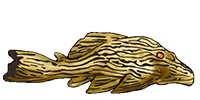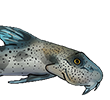| Scientific Name | Panaqolus nocturnus (Schaefer & Stewart, 1993) |
| Common Names | L329, Dusky Panaque Natsugemalle (Denmark), Night Pleco |
| Type Locality | Río Santiago near la Poza, Río Marañón basin, 4°01'24''S, 77°45'06''W, Depart. Amazonas, Peru. |
| Synonym(s) | Panaque nocturnus |
| Pronunciation | pan ack oh luss - nock-turn-us |
| Etymology | Panaqolus: Inelegantly derived from the indigenous term Panaque and in a form that infers a smaller size than that genus. The specific epithet nocturnus refers to the night, presumably because the fish is mainly nocturnal. |
| Size | 139mm or 5.5" SL. Find near, nearer or same sized spp. |
| Identification | The typical colour pattern is overall darkly coloured with very indistinct patterning consisting of blotches on the body and faint bands in the caudal. Younger fishes or individuals (perhaps stressed) can show more distinct banding in the fins. Given this range in colouration, it is difficult to distinguish between juvenile individuals and the sympatric species Panaqolus gnomus in the field. (Lujan, pers. comm, 2020). |
| Sexing | Like all members of the genus, males grow elongated interopercular odontodes during the breeding season. Males develop noticeable odontodes along the dorsum (back of the body) as well. Males develop small pointed genital papillae, whereas mature females will have large, rounded, swollen papillae. Additionally, gravid females have noticeably wider bodies between the pectoral and pelvic fins when viewed from above, compared to males. |
| General Remarks | In the Marañon River, Panaqolus nocturnus was the most abundant loricariid on coarse woody debris dams near Santa Maria de Nieva. |
| Distribution | South America: Santiago and Pastaza River basins in upper Napo drainage. Amazon, Upper Amazon, Marañón, Pastaza (click on these areas to find other species found there) Amazon, Upper Amazon, Marañón, Upper Marañón, Santiago (click on these areas to find other species found there) Login to view the map. |
| IUCN Red List Category | Least Concern , range map and more is available on the IUCN species page. Last assessed 2014. |
| Feeding | This genus feeds on wood, and should have several pieces, preferably several kinds of wood to chew on. Aside from wood, a mainly vegetarian diet is recommended, prepared food such as algae wafers and fresh vegetables, such as courgette (zucchini) and tubers such as potato or sweet potato (yams). User data. |
| Furniture | Rock piles are optional and wood tangles are a must. Plants are not vital and will be nibbled or destroyed. |
| Suggested Tankmates | Works well with most types of peaceful community fish. Can be somewhat territorial towards conspecifics, but given enough hiding spaces, a group can be kept in a suitable size aquarium - roughly requiring a 30 x 30cm area per fish. |
| Breeding | Unreported. |
| Breeding Reports | There is no breeding report. |
| Reference | Ichthyological Exploration of Freshwaters v. 4 (no. 4), pp 330, Fig. 15. |
| Registered Keepers | There is no registered keeper. |
| Wishlists | Love this species? Click the heart to add it to your wish list. There is but a single wish to keep this species, see who wants what. |
| Spotters | Spotted this species somewhere? Click the binoculars! There are 5 records of this fish being seen, view them all. |
| Forum BBCode | |
| Search for P. nocturnus | |
| Look up P. nocturnus on AquaticRepublic.com | |
 | Look up P. nocturnus on Fishbase |
 | Look up P. nocturnus on Encyclopedia of Life |
 | Look up P. nocturnus on Global Biodiversity Information Facility |
| LFS label creator ARN ref:1.4.762.699 | |
| Last Update | 2025 Jan 01 12:14 (species record created: 2007 Feb 13 22:50) |





/siluriformes/loricariidae/panaqolus/nocturnus/1.jpg)
/siluriformes/loricariidae/panaqolus/nocturnus/2.jpg)
/siluriformes/loricariidae/panaqolus/nocturnus/3.jpg)
/siluriformes/loricariidae/panaqolus/nocturnus/4.jpg)
/siluriformes/loricariidae/panaqolus/nocturnus/5.jpg)
/siluriformes/loricariidae/panaqolus/nocturnus/6.jpg)
/siluriformes/loricariidae/panaqolus/nocturnus/7.jpg)
/siluriformes/loricariidae/panaqolus/nocturnus/8.jpg)
/siluriformes/loricariidae/panaqolus/nocturnus/9.jpg)
/siluriformes/loricariidae/panaqolus/nocturnus/10.jpg)
/siluriformes/loricariidae/panaqolus/nocturnus/11.jpg)
/siluriformes/loricariidae/panaqolus/nocturnus/12.jpg)
/siluriformes/loricariidae/panaqolus/nocturnus/13.jpg)
/siluriformes/loricariidae/panaqolus/nocturnus/14.jpg)
/siluriformes/loricariidae/panaqolus/nocturnus/15.jpg)
/siluriformes/loricariidae/panaqolus/nocturnus/16.jpg)
/siluriformes/loricariidae/panaqolus/nocturnus/17.jpg)
/siluriformes/loricariidae/panaqolus/nocturnus/18.jpg)
/siluriformes/loricariidae/panaqolus/nocturnus/19.jpg)